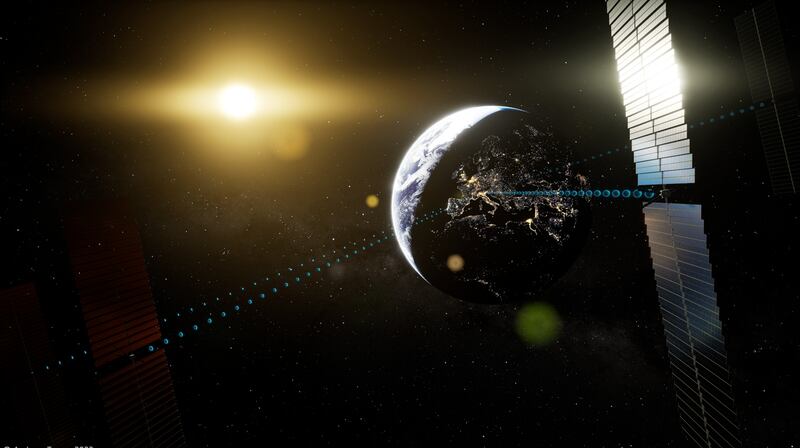Solar panels could be stationed in orbit in a huge multi-country project similar to the International Space Station, The National has been told.
The floating solar farm would collect the Sun's energy – with no clouds in the way – and beam it wirelessly back to Earth using electromagnetic waves.
A space summit in London was told the concept is “entering mainstream conversations” but a lack of funding is holding up research.
Nonetheless, making the technology viable by 2050 “sounds very doable”, said Paul Bate, the chief executive of the UK Space Agency, who called for countries to work together on the idea.
“Something that is beaming power down, we may well want to share that resource. It's not going to be based in any particular country,” he told The National.
“No one's ever built anything this big in space before. It's an order of magnitude bigger than anything anyone's built. So we have no monopoly on that expertise.
“Looking at something like the International Space Station, that's been built by multiple countries. We would expect that to be happening again here.”
Space bosses on Wednesday pledged support to an idea hailed as “truly transformational” in the search for clean, stable power sources.
Engineers have been tasked with working out how to make the novel technology workable and safe from space debris or sabotage.
A key benefit is that, unlike solar power on Earth, it would not be weather-dependent.

The UK “is trying to build a secure energy supply for when wind doesn’t blow and the Sun doesn’t shine”, said Energy Minister Amanda Solloway.
“That is precisely why space solar is just a fantastic opportunity and this is why we need to pursue it.”
As part of net-zero plans, the UK has a target to produce 70 gigawatts of solar power by 2035, a five-fold increase.
But space could take that “considerably higher – quite literally, and perhaps even 35,000km higher,” Ms Solloway said.
Britain is “determined to make sure we get the full potential of space solar in the future energy mix”, she said.
However, investment in the field “remains low” compared to other clean technology, said Josef Aschbacher, the head of the European Space Agency.
Some of the technology is in its infancy and there are questions about costs, debris and the huge size of the project.
One estimate is that a solar farm in orbit would be 17 times the size of the International Space Station, which is due for retirement in 2031.
There are doubts whether research commissioned by the European Space Agency will be ready in time for a 2025 deadline to decide whether to move forward.
Europe has also faced problems in independently launching spacecraft, especially after collaboration with Russia ended due to the war in Ukraine.
Officials want to see more energy companies signal their interest, with France's Engie involved in the mirror study and the UK branch of EDF looking into the impact of solar storms.
Mr Aschbacher said a “significant boost” in research funding would be vital and could bring wider benefits such as developing wireless transmission technology.
Nations at risk due to climate change – in pictures
The idea is that energy captured in space is picked up on Earth by a special antenna (a rectenna) hooked up to power grids.
An alternative being explored in France is to use mirrors stationed in space to reflect sunlight back to receivers on Earth.
“To accelerate the transition to clean energy, we need to innovate beyond conventional solutions,” Mr Aschbacher said.
“Space solutions such as space-based solar power hold immense promise in catalysing this change.”
A new solar power supply in 2050 would come too late to slash carbon emissions before then but could provide a longer-term “baseload”.
Mr Bate said tests on small-scale demonstrators would show whether “technological leaps” will make it possible before then or whether new barriers will emerge.
But “2050, so 25 years away, sounds very doable from the independent analysis to date, and it could be even sooner than that,” he said.



















